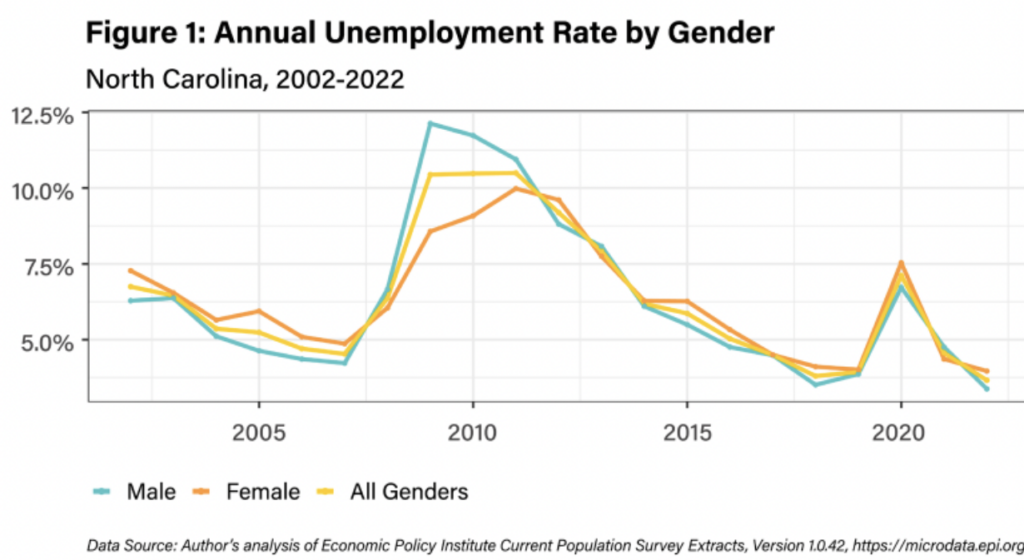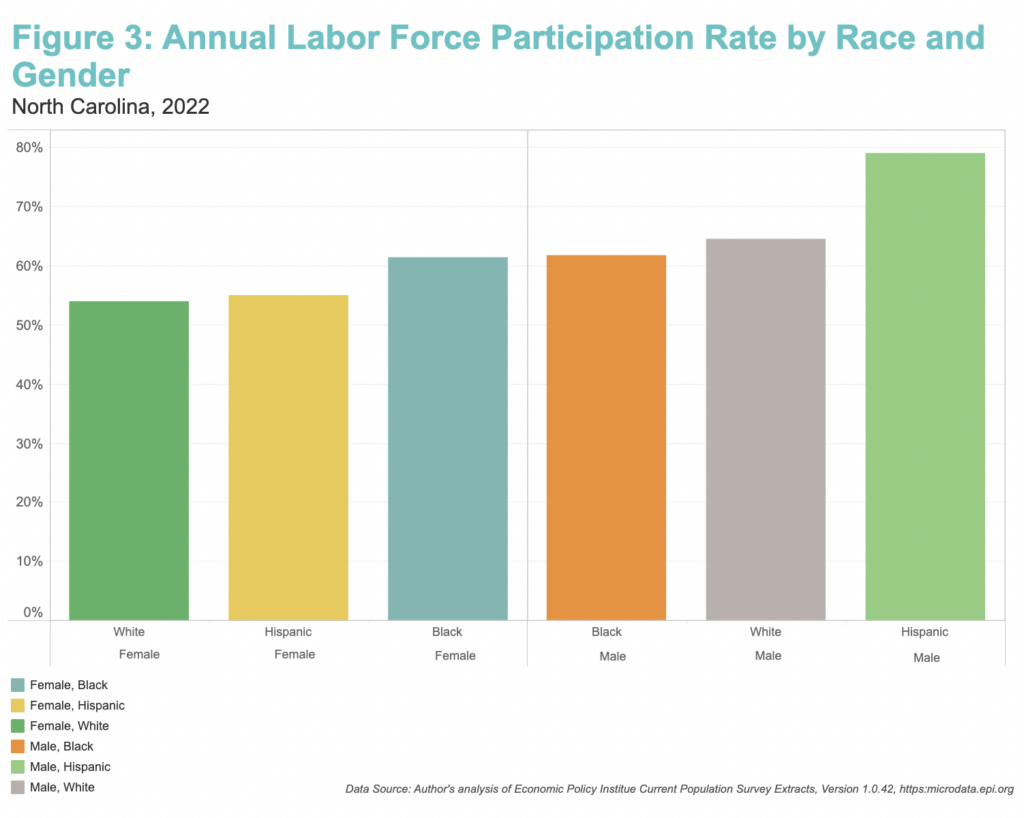For the past two years, unemployment in North Carolina has done more than return to pre-pandemic levels; it’s dropped to the lowest level in more than 20 years. A closer look, however, reveals a more complicated picture — for the state’s women and, especially for women of color.
When Oxfam America recently released its ranking of the Best and Worst States to Work in America, North Carolina came in last in wages, worker protections and organizing rights. The state was ranked worst in the nation for working women.
This year’s State of Working Women report, released this month by the North Carolina Justice Center’s Workers’ Rights Project, outlines the challenges women continue to face and the reasons many are no longer seeking work. It also profiles individual women who are trying to change those conditions, such as addressing job policies that disproportionately affect women and organizing workplaces as part of a national uptick in unionization.
“These are not problems without solutions, but our state’s employers and elected leaders have yet to meaningfully address them,” said Ana Pardo, co-director of the Workers’ Rights Project, in a statement accompanying the report. “It’s no coincidence that working women are leading the charge to organize their workplaces here and elsewhere in the country; they have absolutely been pushed to their limits.”
Today, a by-the-numbers look at the state of working women’s lives in North Carolina.
(Sources: The Workers’ Rights Project’s 2023 State of Working Women report, Oxfam America’s Best and Worst States to Work in America 2023, data from The U.S. Bureau of Labor Statistics and the National Labor Relations Board.)
4% – Unemployment rate for women in North Carolina, 2022
3.4% – Unemployment rate for men in North Carolina, 2022

“Over the last two decades, the unemployment rate was usually higher for women than for men,” the State of Working Women report notes. “With the notable exception of four years during the Great Recession as well as in 2021.”
As the report demonstrates, the unemployment rate tends to vary more by race than strictly by gender.
7.5% – Unemployment rate for Black women in North Carolina, 2022
5.9% – Unemployment rate for Black men in North Carolina, 2022
Unemployment rates, while often the most cited of economic indicators, give only a partial picture. As the report notes, these rates only measure those who are unemployed as a percentage of the total workforce. That omits the portion of the adult population that isn’t actively seeking work Nor do the rates explain people’s motivations for leaving or not joining the workforce.
The labor participation rate, the percentage of adult population working or actively looking for work, helps to look beyond unemployment rates alone.
“Nationally, women’s labor force participation rate increased over the last half of the 20th century,” the report reads. “Since the turn of the century, the labor force participation rate of both men and women has fallen, mostly due to the aging of the Baby Boomer generation and other structural and cyclical factors.”
This holds true in North Carolina, the report explains, and shows a clear gender divide.
65.9% – Annual average labor force participation rate for men in North Carolina., 2022
56% – Annual average labor force participation rate for women in North Carolina, 2022

“Longstanding attitudes about women’s roles in the workforce and as caregivers mean women continue to face discrimination in hiring and advancement, are pushed into occupations traditionally designated for women, and leave the workforce in greater numbers when childcare and other family care responsibilities arise,” the report reads. “Women face several health and safety concerns which impact their ability to remain and advance in the workforce. Pregnancy, workplace sexual harassment, and intimate partner violence are all obstacles which have disproportionate impacts on women, particularly on women of color and immigrant women.”
Again, factoring in race provides a more complete picture.
“Across gender and race, the labor force participation rate is highest among Hispanic men (79.1 percent) and lowest among white women (53.9 percent),” the report reads. “White, Black, and Hispanic men all have higher labor force participation rates than women of the same race or ethnicity.”

“North Carolina families with young children spent approximately 25 percent of their income on childcare in 2018,” the report reads. “Scarce affordable caregiving options force families to make sacrifices to care for their own, which typically means women are putting their careers on hold and forgoing income.”
The report cites a study for the U.S. Department of Labor Women’s Bureau in which the Urban Institute found mothers, on average, lose out on $295,0000 in earnings and retirement income. That’s roughly 15% of their potential lifetime income. The loss was even greater among less-educated mothers, who lose out on 26% of potential lifetime income.
“The size of the care economy is hard to assess because much care work is unpaid,” the report reads. “One 2022 study estimated the total value of the care economy, both paid and unpaid, at $6 trillion, or roughly one quarter of the entire U.S. gross domestic product (GDP). This includes $2.5 to $3.5 trillion in unpaid care labor, $2.2 trillion in the formal care economy, and $400 billion in the “gray economy” (labor that is paid under the table and not counted in most economic statistics). A 2012 study found a similar value, $3.2 trillion, for unpaid caregiving work.”
One driving factor in the statistical differences seen between genders in the data: the very different occupations in which men and women are concentrated, often due to both traditional attitudes about gender and their types of labor, as well as expectations that women will disproportionately perform unpaid labor in child care and family health care.
343,000 – Approximate number of women in North Carolina who worked in office and administrative support jobs, 2022
72% – Share of all such jobs in North Carolina occupied by women
91% – Share of healthcare support workers who were women in North Carolina, 2022
86% – Share of personal care and service workers who were women in North Carolina, 2022
81% – Share of workers who were women in healthcare practitioner and related technical occupations in North Carolina, 2022
77% – Share of workers who were women in education, training and library occupations in North Carolina, 2022
60% – Share of workers who were men in management occupations in North Carolina. This category had the third-largest number of women workers at nearly 247,000, but given the gender gap, the report calls men “overrepresented” in this group.




